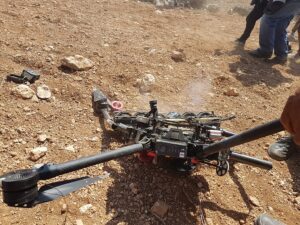
Regulators, insurers, advanced drone operators and community members all want to know: what’s the real risk of a falling drone? From the floor of Intergeo 2023: how to quantify the risk.
Laura Gonzalez Combrink of Accenture consulting gave a presentation on their initiative to enhance existing data sets, in order to determine and quantify the risk of falling drones. Quantifying this risk, Gonzalez says, could be foundational to reaching the next level of integration of drones into existing airspace.
It’s a significant problem. Risk-based operations require accurate assessment of the ground risk of falling drones: but that depends upon an accurate understanding of who is likely to be on the ground if a drone falls. To determine the risk of drone missions that overlap with population centers, it’s a critical piece of drone integration. “As drones become more integrated with the fabric of everyday life, determining the likelihood of this occurring is increasingly important,” said Ms. Combrink.
GRADE: Ground Risk of Drone Operations
Simply put, GRADE, or the ground risk of drone operations, is designed to answer the essential quesiton: how likely is a falling drone to hit someone? Currently, experts use census data: but this has limitations. “Census data is limited, as it is static data, it does not take into account changes in household… it’s focused on buildings, and is infrequently updated,” says Ms. Combrink.
Ms. Combrink explains that the goal of their work on risk models is to include more and relevant data: such as the movement of people, whether they are likely to be located inside or outside of buildings, the possibility of higher density based upon the time of day, and specific locations with higher density levels. At noon, for example, a city block would have more people outside than that same location at 3 am. Accenture uses Census data augmented by autonomous crowd data, such as mobile phone users and usage, population flows, and land usage information.
Enabling Autonomous Flight
Eventually, said Combrink, the result of this data set could enabled autonomous flight and advanced operations. Integrated into flight planning tools, the data could help to establish a better and safer flight path, and possibly integrated into SORA. By avoiding populated areas at relevant times, the system would give operators more options for safe flight paths while reducing ground-based risk.
[The team is in discussions with EU regulatory authorities, but the GRADE systems has not yet been authorized by the EU for SORA usage.]
Read more:
- Drone Boom Puts Insurers at Risk of Multi-Million Dollar Bill
- Archer First Response Systems, Drone Rescue Systems Complete Latest ASTM Standards for Drone Parachute Recovery Systems
- What Happened When (If) a Drone Hit a Helicopter? What the Real Data Shows.
- Team Studies Drone Strikes on Airplanes by Firing Them into a Wall at 500 MPH
CEO DroneLife.com, DroneRacingLife.com, and CMO of Jobfordrones.com. Principle at Spalding Barker Strategies. Has enjoyed working with and around the commercial drone industry for the last 10 years. Attendance and speaker at Industry Events such as Commercial UAV, InterGeo, Interdrone and others. Proud father of two. Enjoys karate, Sherlock Holmes, and interesting things. Subscribe to all things drone at DroneLife here. Email is Harry@dronelife.com. Make Sure that you WhiteList us in your email to make sure you get our Newsletter. Editor1@dronelife.com.